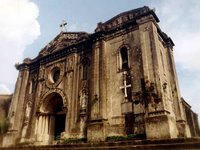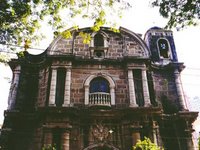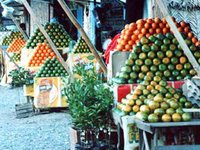 I don't usually post articles in full here in my blog; but since the Philippine Star website doesn't keep an archive of its past articles, I'm posting this really great article about Makati here. Imagine, if a highly-urbanized city such as Makati thinks this way, then the more other cities and municipalities should!Makati's other face, the older one, is unknown to most Filipinos since we have always known it as the country's business center. But along the banks of the Pasig River, in the J.P. Rizal and Makati-Pateros Road areas, you'd be surprised to find centuries-old churches and other heritage structures.
I don't usually post articles in full here in my blog; but since the Philippine Star website doesn't keep an archive of its past articles, I'm posting this really great article about Makati here. Imagine, if a highly-urbanized city such as Makati thinks this way, then the more other cities and municipalities should!Makati's other face, the older one, is unknown to most Filipinos since we have always known it as the country's business center. But along the banks of the Pasig River, in the J.P. Rizal and Makati-Pateros Road areas, you'd be surprised to find centuries-old churches and other heritage structures. Among its built heritage resources are the ruins of the Church of the Nuestra Senora de Gracia in Guadalupe Viejo (above) and the Saints Peter and Paul Church in Barangay Poblacion (right) which when I visited it a few months back, still had an intact interior complete with a wooden retablo and old floor tiles. While driving along the Makati-Pateros Road, I was also suprised to see an old chapel with an unaltered facade! I wonder how it looks inside. Photos are from the Makati City portal.
Among its built heritage resources are the ruins of the Church of the Nuestra Senora de Gracia in Guadalupe Viejo (above) and the Saints Peter and Paul Church in Barangay Poblacion (right) which when I visited it a few months back, still had an intact interior complete with a wooden retablo and old floor tiles. While driving along the Makati-Pateros Road, I was also suprised to see an old chapel with an unaltered facade! I wonder how it looks inside. Photos are from the Makati City portal.
Unlike many towns and cities which demolish or renovate their old municipal halls, Makati preserved theirs and built a modern one in a different location. Their old municipal hall is now the Museo ng Makati.  But the poblacion and barangays along the Pasig River are not the only ones with heritage structures. Don't forget the Nielson Tower, our old pre-war airport along Makati Avenue which is now the Filipinas Heritage Library, as well as the Manila Polo Club, the Santuario de San Antonio in Forbes Park, and the Sta. Ana Race Track among others. The Makati portal also mentions the Libingan ng mga Bayani and the American Cemetery and Memorial but these sites are now part of Taguig City.I'm sure you'll be happy reading the article below. Two thumbs up to Makati mayor Jejomar Binay! I hope Manila mayor Lito Atienza follows your noble example.Makati seeks to rediscover its pastBy Michael PunongbayanThe Philippine Star 08/30/2006The country's financial capital, known for its high-rise buildings and commercial centers, now wants to rediscover its past as it steps back in time to unravel its rich culture and traditions.The Makati City government, with the help of historians and other experts, has launched a Heritage Conservation Program (HCP), which will retrace, re-learn and help residents appreciate the city's history with the synergy of past and present to foster future growth and development.Mayor Jejomar Binay said he has foreseen the value of preserving the culture of Makati City anchored in the old adage, "ang hindi marunong lumingon sa pinanggalingan ay hindi makakarating sa paroroonan."Barangay Poblacion, the historical seat of Makati City's traditions and governance, has been chosen as the pilot barangay where the first Heritage Zone will rise.To realize this goal, Binay has sought the assistance of Instituto Cervantes' Spanish Program for Cultural Cooperation (SPCC) and the FEATI University.Dr. Julio Galvan, general coordinator of the SPCC has signed an agreement with Binay, which releases to the city government a P200,000 grant that will help fund the cultural mapping of Barangay Poblacion.Binay said completing the three-way partnership is Feati University represented by its president Dr. Adolfo Jesus Gopez.The academic institution will provide cultural experts, professors and a research staff that will conduct the cultural mapping of Barangay Poblacion."They will document historical structures and landmarks and ingrained practices and beliefs," Binay announced.He said a heritage preservation plan will be created from the data gathered by the study group up to November this year.Binay added that he has assembled a committee composed of representatives from the city government, residents and the private sector to oversee the heritage project.With the help of Instituto Cervantes and Feati University, he expressed confidence in the program that will relive the past for the people of the present while inspiring future generations.
But the poblacion and barangays along the Pasig River are not the only ones with heritage structures. Don't forget the Nielson Tower, our old pre-war airport along Makati Avenue which is now the Filipinas Heritage Library, as well as the Manila Polo Club, the Santuario de San Antonio in Forbes Park, and the Sta. Ana Race Track among others. The Makati portal also mentions the Libingan ng mga Bayani and the American Cemetery and Memorial but these sites are now part of Taguig City.I'm sure you'll be happy reading the article below. Two thumbs up to Makati mayor Jejomar Binay! I hope Manila mayor Lito Atienza follows your noble example.Makati seeks to rediscover its pastBy Michael PunongbayanThe Philippine Star 08/30/2006The country's financial capital, known for its high-rise buildings and commercial centers, now wants to rediscover its past as it steps back in time to unravel its rich culture and traditions.The Makati City government, with the help of historians and other experts, has launched a Heritage Conservation Program (HCP), which will retrace, re-learn and help residents appreciate the city's history with the synergy of past and present to foster future growth and development.Mayor Jejomar Binay said he has foreseen the value of preserving the culture of Makati City anchored in the old adage, "ang hindi marunong lumingon sa pinanggalingan ay hindi makakarating sa paroroonan."Barangay Poblacion, the historical seat of Makati City's traditions and governance, has been chosen as the pilot barangay where the first Heritage Zone will rise.To realize this goal, Binay has sought the assistance of Instituto Cervantes' Spanish Program for Cultural Cooperation (SPCC) and the FEATI University.Dr. Julio Galvan, general coordinator of the SPCC has signed an agreement with Binay, which releases to the city government a P200,000 grant that will help fund the cultural mapping of Barangay Poblacion.Binay said completing the three-way partnership is Feati University represented by its president Dr. Adolfo Jesus Gopez.The academic institution will provide cultural experts, professors and a research staff that will conduct the cultural mapping of Barangay Poblacion."They will document historical structures and landmarks and ingrained practices and beliefs," Binay announced.He said a heritage preservation plan will be created from the data gathered by the study group up to November this year.Binay added that he has assembled a committee composed of representatives from the city government, residents and the private sector to oversee the heritage project.With the help of Instituto Cervantes and Feati University, he expressed confidence in the program that will relive the past for the people of the present while inspiring future generations.
Since we're already in the process of digging out those albums from the baul, here is another trip from the archives. The thing I like about conferences is that many of them are out of town and the last day is usually reserved for a tour of the locality. This one was a conference on history held in Nueva Vizcaya, a province most known for its citrus fruits. The Center for Kapampangan Studies sent me and Prof. Lino Dizon to attend in the Center's behalf. From Pampanga, I passed by for Lino in Tarlac. Then we made an eastward trip towards the Maharlika Highway via Guimba, Nueva Ecija. It was the first time for me to visit Cagayan Valley and the views along the way especially as we entered Carranglan were quite refreshing. It was also significant for us since Carranglan used to be the last town of the original Provincia de la Pampanga. Make sure you have a lot of gas since the distance between the last town of Nueva Ecija and the next town in Nueva Vizcaya is over 40 kilometers!
From Pampanga, I passed by for Lino in Tarlac. Then we made an eastward trip towards the Maharlika Highway via Guimba, Nueva Ecija. It was the first time for me to visit Cagayan Valley and the views along the way especially as we entered Carranglan were quite refreshing. It was also significant for us since Carranglan used to be the last town of the original Provincia de la Pampanga. Make sure you have a lot of gas since the distance between the last town of Nueva Ecija and the next town in Nueva Vizcaya is over 40 kilometers!
 Along the highway in Santa Fe, I noticed shops selling baskets, salakots and other rattan products. I made sure to buy salakots on the way back to add to my collection.
Along the highway in Santa Fe, I noticed shops selling baskets, salakots and other rattan products. I made sure to buy salakots on the way back to add to my collection.
After several hours of driving, we finally arrived in Bayombong, the provincial capital. We were already late for the first day (I don't remember why we left late) and arrived just in time for the end of day's activities.Since the hotels in Bayombong were fully-booked, the Center made reservations for us at the Governor's Hotel in Solano, which is the commercial center of the province and just a few minutes away from Bayombong. Actually, that was better for us since the hotel was among the better ones in the province. Hehe! Also billeted in the hotel was Tingting Cojuangco who was attending the conference as well. Lino was actually one of her doctoral dissertation advisers so we had dinner or breakfast with her every once in a while. Anyway, during one of the conference days, Lino and I decided to sneak away from the afternoon sessions to make a side trip to Banaue since it was quite close. But we passed by the town of Kiangan first to check it out. Among the places we visited was the 1945 surrender site of Gen. Tomoyuki Yamashita, the Tiger of Malaya. It is now a military shrine known as Bantayog sa Kiangan.Notice the website of the shrine since it mentions that the surrender of Yamashita was in 1942! Shame on the PVAO since it shows they don't know their history. We all know that 1942 was the Fall of Bataan!
Anyway, during one of the conference days, Lino and I decided to sneak away from the afternoon sessions to make a side trip to Banaue since it was quite close. But we passed by the town of Kiangan first to check it out. Among the places we visited was the 1945 surrender site of Gen. Tomoyuki Yamashita, the Tiger of Malaya. It is now a military shrine known as Bantayog sa Kiangan.Notice the website of the shrine since it mentions that the surrender of Yamashita was in 1942! Shame on the PVAO since it shows they don't know their history. We all know that 1942 was the Fall of Bataan! It was getting late and we still had Banaue on our list. The sun was still up when we arrived in the town proper. We could have made it to the viewpoint in time for photos but for some stupid reason, I made a wrong turn somewhere an ended up on the road to Mayoyao instead of the one to Bontoc. So to make the long story short, we weren't able to take photos with the famed rice terraces! Sigh! Good thing I came back this year.Before we left Banaue, I passed by a souvenir shop to buy some miniature bulol (rice gods) which were dirt cheap! I got them for PHP50 each when a smaller one I bought in Baguio many years back was PHP250!The next day was our trip around Nueva Vizcaya. During breakfast, Lino handed me a salakot which Tingting had bought for me since she found out during one of our conversations that I was colecting salakots. It was really nice of her. She had already left for Manila.
It was getting late and we still had Banaue on our list. The sun was still up when we arrived in the town proper. We could have made it to the viewpoint in time for photos but for some stupid reason, I made a wrong turn somewhere an ended up on the road to Mayoyao instead of the one to Bontoc. So to make the long story short, we weren't able to take photos with the famed rice terraces! Sigh! Good thing I came back this year.Before we left Banaue, I passed by a souvenir shop to buy some miniature bulol (rice gods) which were dirt cheap! I got them for PHP50 each when a smaller one I bought in Baguio many years back was PHP250!The next day was our trip around Nueva Vizcaya. During breakfast, Lino handed me a salakot which Tingting had bought for me since she found out during one of our conversations that I was colecting salakots. It was really nice of her. She had already left for Manila. We drove back to Bayombong which was the meeting place for the trip. Our first stop was the Church of San Vicente Ferrer in Dupax del Sur which was declared a national cultural treasure the year before. For some reason, I misplaced my photos of the church since I separated it from the other Nueva Vizcaya photos for scanning. So we will have to make do with a photo from this tourism site.According to the NCCA website, "this Dominican church was established in the late 18th century and features a baptistery and narthex pillars covered with finely carved stucco. The church’s convent retains some features from its violent past, such as slits on the outer walls which were used by archers to defend against attacks."
We drove back to Bayombong which was the meeting place for the trip. Our first stop was the Church of San Vicente Ferrer in Dupax del Sur which was declared a national cultural treasure the year before. For some reason, I misplaced my photos of the church since I separated it from the other Nueva Vizcaya photos for scanning. So we will have to make do with a photo from this tourism site.According to the NCCA website, "this Dominican church was established in the late 18th century and features a baptistery and narthex pillars covered with finely carved stucco. The church’s convent retains some features from its violent past, such as slits on the outer walls which were used by archers to defend against attacks." From Dupax del Sur, we made a trip further down south to Dalton Pass in Sta. Fe, the boundary of Nueva Ecija and Nueva Vizcaya. According to the DOT website, being "the only access between Pampanga and Cagayan Valley, the pass became the scene of much bloody fighting during the final stages of WW II and bore witness to the death of almost 17,000 Japanese, American, and Filipino soldiers. Commemorative markers stand by the road’s highest point, which also offers a good view into the headlands. The Dalton Pass National Shrine commemorates the death of General Dalton by a sniper’s bullet during WW II. At 3,000 feet above sea level, Dalton Pass is also the gateway to the Cagayan Valley Region and the Ifugao Rice Terraces."
From Dupax del Sur, we made a trip further down south to Dalton Pass in Sta. Fe, the boundary of Nueva Ecija and Nueva Vizcaya. According to the DOT website, being "the only access between Pampanga and Cagayan Valley, the pass became the scene of much bloody fighting during the final stages of WW II and bore witness to the death of almost 17,000 Japanese, American, and Filipino soldiers. Commemorative markers stand by the road’s highest point, which also offers a good view into the headlands. The Dalton Pass National Shrine commemorates the death of General Dalton by a sniper’s bullet during WW II. At 3,000 feet above sea level, Dalton Pass is also the gateway to the Cagayan Valley Region and the Ifugao Rice Terraces." The group stopped over along the road in Santa Fe to buy souvenirs. So I took this opportunity to purchase salakots for my collection. It was then up the mountain trail to the Ikalahan "Mountain Fresh" factory in Barangay Imugan which is famous for its various spreads and dried fruits. The Ikalahan are a tribal minority residing in the Caraballo Mountains.One of their unique products are the dagwey (Saurauia bontocensis) preserve, jelly and spread. I liked especially the dagwey preserve which is the local version of prunes using the indigenous fruit. There are also guava (Psidium guajava) jelly, jam and butter; dikay (Embelia philippinensis) jelly; ginger (Zingiber officinale) jelly; passion fruit (Passiflora edulis) jelly; roselle (Hibiscus sabdariffa) jelly; and santol (Sandoricum koetjape) jelly and spread. You could read the whole story of this backyard industry in this FAO report.
The group stopped over along the road in Santa Fe to buy souvenirs. So I took this opportunity to purchase salakots for my collection. It was then up the mountain trail to the Ikalahan "Mountain Fresh" factory in Barangay Imugan which is famous for its various spreads and dried fruits. The Ikalahan are a tribal minority residing in the Caraballo Mountains.One of their unique products are the dagwey (Saurauia bontocensis) preserve, jelly and spread. I liked especially the dagwey preserve which is the local version of prunes using the indigenous fruit. There are also guava (Psidium guajava) jelly, jam and butter; dikay (Embelia philippinensis) jelly; ginger (Zingiber officinale) jelly; passion fruit (Passiflora edulis) jelly; roselle (Hibiscus sabdariffa) jelly; and santol (Sandoricum koetjape) jelly and spread. You could read the whole story of this backyard industry in this FAO report. A trip to Nueva Vizcaya would not be complete without a taste of its famous citrus fruit, the perante. On the way back to Bayombong proper, we bought perantes at popular roadside fruit stand in Bayombong. I also got myself some seedlings which I planted in our backyard orchard in Pampanga.According to the DOT, "citrus fruits and oranges which are available all year round and being propagated in the towns of Kasibu, Kayapa, and Ambaguio and can be bought along the national highway at Busilac, Bayombong, making Nueva Vizcaya the Citrus Capital of the Philippines. Common varieties include perante, valencia, clementine, satsuma, pongkan, Washington navel, pomelo, calamansi, and others."
A trip to Nueva Vizcaya would not be complete without a taste of its famous citrus fruit, the perante. On the way back to Bayombong proper, we bought perantes at popular roadside fruit stand in Bayombong. I also got myself some seedlings which I planted in our backyard orchard in Pampanga.According to the DOT, "citrus fruits and oranges which are available all year round and being propagated in the towns of Kasibu, Kayapa, and Ambaguio and can be bought along the national highway at Busilac, Bayombong, making Nueva Vizcaya the Citrus Capital of the Philippines. Common varieties include perante, valencia, clementine, satsuma, pongkan, Washington navel, pomelo, calamansi, and others."
Thanks to Bong Austero for that nice write-up about the blog in his column Are We There Yet? (30 August 2006). Here are excerpts from his column:
There are hundreds of thousands of blogs out there. There are blogs that entertain; some intentionally, others purely by accident. There are blogs that educate; some deliberately, others through vicarious and accidental learning. There are blogs that advocate certain causes. And then there are blogs that are able to do all three and more. I have been meaning to write about some of them mainly because of the causes they spouse.
Ivan Henares’s blog (www.ivanhenares.blogspot.com) is one blog that truly deserves to get more traffic. Ivan’s blog is a travel and heritage journal (the blog’s title is “Ivan About Town”) as it documents his many sojourns across the country and other parts of the world. I do not know Ivan personally so I do not know if he is as frisky; but in a way, he is like the local Ian Wright of Lonely Planet sans the television camera. Ian has television, Ivan has the blogosphere. Ivan goes to places and shares the experiences in his blog; he even gives details such as how much a jeepney ride from this point to that point, or how much lodging or dinner costs in this or that place.
But Ivan’s main advocacy is preservation of Philippine heritage. And this is what makes his blog truly worth supporting. His current advocacy is preservation of old churches, which are systematically being demolished to give way to some local parish priests’ demented attempt to establish their “legacy” in their parishes. The extent to which such aspirations of greatness translate into destroying centuries-old churches is already alarming.
 I don't usually post articles in full here in my blog; but since the Philippine Star website doesn't keep an archive of its past articles, I'm posting this really great article about Makati here. Imagine, if a highly-urbanized city such as Makati thinks this way, then the more other cities and municipalities should!
I don't usually post articles in full here in my blog; but since the Philippine Star website doesn't keep an archive of its past articles, I'm posting this really great article about Makati here. Imagine, if a highly-urbanized city such as Makati thinks this way, then the more other cities and municipalities should! Among its built heritage resources are the ruins of the Church of the Nuestra Senora de Gracia in Guadalupe Viejo (above) and the Saints Peter and Paul Church in Barangay Poblacion (right) which when I visited it a few months back, still had an intact interior complete with a wooden retablo and old floor tiles. While driving along the Makati-Pateros Road, I was also suprised to see an old chapel with an unaltered facade! I wonder how it looks inside. Photos are from the Makati City portal.
Among its built heritage resources are the ruins of the Church of the Nuestra Senora de Gracia in Guadalupe Viejo (above) and the Saints Peter and Paul Church in Barangay Poblacion (right) which when I visited it a few months back, still had an intact interior complete with a wooden retablo and old floor tiles. While driving along the Makati-Pateros Road, I was also suprised to see an old chapel with an unaltered facade! I wonder how it looks inside. Photos are from the Makati City portal. But the poblacion and barangays along the Pasig River are not the only ones with heritage structures. Don't forget the Nielson Tower, our old pre-war airport along Makati Avenue which is now the Filipinas Heritage Library, as well as the Manila Polo Club, the Santuario de San Antonio in Forbes Park, and the Sta. Ana Race Track among others. The Makati portal also mentions the Libingan ng mga Bayani and the American Cemetery and Memorial but these sites are now part of Taguig City.
But the poblacion and barangays along the Pasig River are not the only ones with heritage structures. Don't forget the Nielson Tower, our old pre-war airport along Makati Avenue which is now the Filipinas Heritage Library, as well as the Manila Polo Club, the Santuario de San Antonio in Forbes Park, and the Sta. Ana Race Track among others. The Makati portal also mentions the Libingan ng mga Bayani and the American Cemetery and Memorial but these sites are now part of Taguig City.







